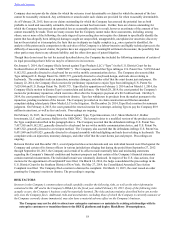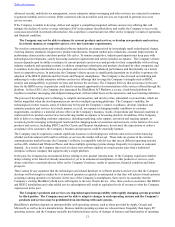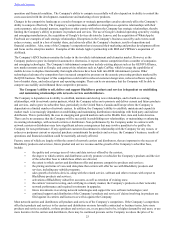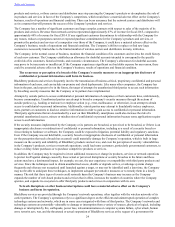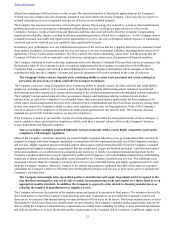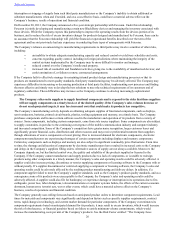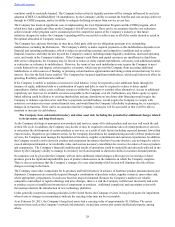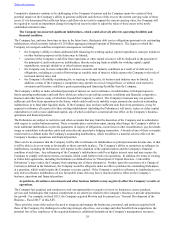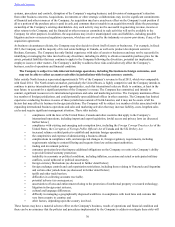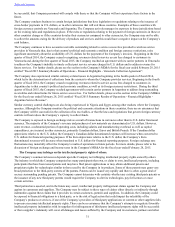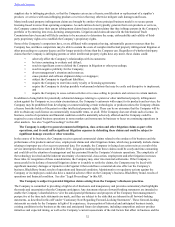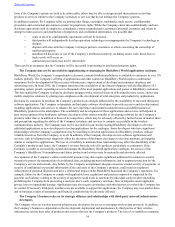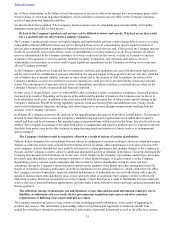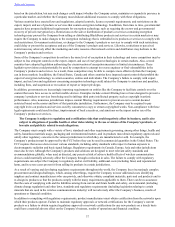Blackberry 2015 Annual Report Download - page 36
Download and view the complete annual report
Please find page 36 of the 2015 Blackberry annual report below. You can navigate through the pages in the report by either clicking on the pages listed below, or by using the keyword search tool below to find specific information within the annual report.
Table of Contents
27
substantial inventory and other asset risk, including the potential for additional charges related to its inventory and long-lived
assets”. If the Company underestimates component requirements, it may have inadequate inventory, which could interrupt
manufacturing operations and delay delivery of products. Any of these occurrences could have a material adverse effect on the
Company’s business, results of operations and financial condition.
The Company has negotiated volume-based pricing terms with many of its suppliers and the Company may experience higher
than anticipated costs if current volume-based purchase projections are not met. Some contracts have minimum purchase
commitments and the Company may incur large financial penalties or increased production costs if these commitments are not
met. The Company may also have unused production capacity if its current volume projections are not met, increasing the
Company’s production cost per unit. In addition, some contracts require the Company to agree to a flat fee regardless of
volumes, which can result in higher unit costs than anticipated if demand is lower than anticipated. In the future, as the
Company establishes new pricing terms, reduced demand for any of its products and services could negatively impact future
pricing from suppliers. Any of these outcomes may result in the Company’s products being more costly to manufacture and less
competitive, which could have a material adverse effect on the Company’s business, results of operations and financial
condition.
The Company may not be able to obtain rights to use software or components supplied by third parties.
The Company licenses certain software used in its products and operations from third parties, generally on a non-exclusive
basis, and the Company uses components from suppliers that are reliant on intellectual property used by such suppliers. The
termination of any of these licenses, or the failure of these licensors or suppliers to adequately maintain, protect or update their
software or intellectual property rights, could delay the Company’s ability to ship its products while the Company seeks to
implement alternative technology offered by other sources and could require significant unplanned investments on the
Company’s part if the Company is forced to develop alternative technology internally. In addition, alternative technology may
not be available on commercially reasonable terms from other sources. The Company has not entered into source code escrow
agreements with every software supplier or third party licensor. In the future, it may be necessary or desirable to obtain other
third-party technology licenses relating to one or more of the Company’s products or relating to current or future technologies
to enhance the Company’s product offerings. The Company may not be able to obtain licensing rights to the needed technology
or components on commercially reasonable terms, if at all.
In addition, the Company licenses certain software from third-parties under open source licenses. Use and distribution of open
source software may entail greater risks than use of third-party commercial software, as open source licensors generally do not
provide warranties or other contractual protections regarding infringement claims or the quality of the code. Some open source
licenses contain requirements that the Company make available source code for modifications or derivative works created by
BlackBerry based upon the type of open source software used. If the Company combines its proprietary solutions with open
source software in a certain manner, the Company could, under certain of the open source licenses, be required to release the
source code of the Company's proprietary solutions to the public or offer the Company's solutions to users at no cost. This
could allow the Company's competitors to create similar solutions with lower development effort and time and ultimately could
result in a loss of revenue to the Company.
The terms of many open source licenses have not been interpreted by U.S. courts, and there is a risk that such licenses could be
construed in a manner that could impose unanticipated conditions or restrictions on the Company's ability to commercialize its
products and services. In such an event, the Company could be required to seek licenses from third parties in order to continue
offering its products and services, to re-engineer the Company's products or services or to discontinue the sale of its products
and services in the event re-engineering cannot be accomplished on a timely basis, any of which could materially and adversely
affect the Company's business and operating results.
The Company’s ability to maintain or increase its liquidity and service its debt could be adversely affected by its
ability to generate cash flow by offering competitive products and services and sustaining recent cost reductions.
As of the end of fiscal 2015, the Company had cash, cash equivalents and investments of approximately $3.3 billion with $1.25
billion in indebtedness as a result of the Debenture Financing. The Company generates cash from sales of its products and
services and investment income to fund its operations and investments. The Company’s working capital requirements and cash
flows historically have been, and are expected to continue to be, subject to quarterly and yearly fluctuations, depending on such
factors as timing and success of new product introductions, levels of sales, returns on the Company’s investment portfolio,
timing of deliveries and collection of receivables, inventory levels, capital expenditures, operating expenses, and customer and
supplier terms and conditions.
The Company’s ability to maintain or increase its cash flow and working capital could be adversely affected if it is unable to
successfully drive adoption of BES12 and BlackBerry 10 smartphones or to enhance service revenues or exploit other
opportunities for generation of revenues. In addition, if the Company fails to accurately predict emerging technological trends
and the changing needs of customers and end users, or the features of its new products and services, including its BlackBerry
10 smartphones do not meet the expectations or achieve acceptance of its customers, its cash flow, liquidity and financial



